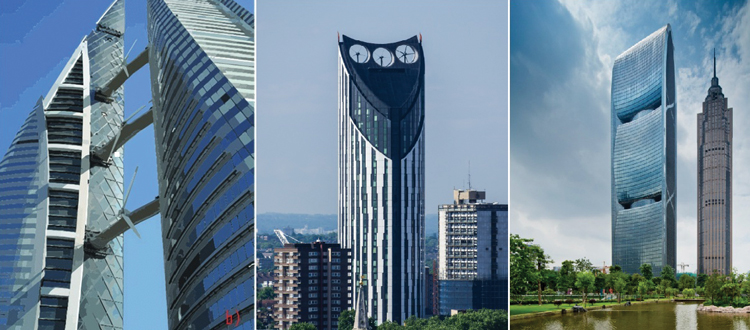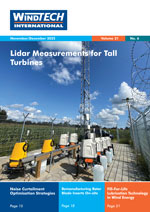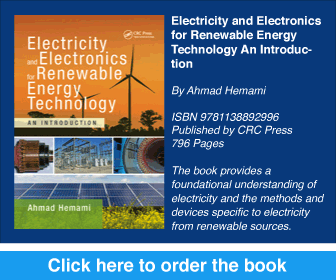It would be fascinating if we could benefit from wind energy to provide a part of the energy consumption of a building. Many people can have the same sort of thinking, since it is free energy and there is plenty of it. I thought the same way in the beginning, about twenty years ago, when I started learning and working on the subject. Especially now that a lot of work is going on about how smart and sustainable buildings can take advantage of integrating renewable energy into the building, this idea looks more reasonable.

By Ahmad Hemami, McGill University, Montreal, Canada
Putting aside all other technologies and arrangements that could be used in a smart building, encompassing a wide range, for instance collection of rainwater, active tinted glasses and automated windows that open and close based on the inside and outside conditions, here we focus only on wind energy.
Although there may exist lots of wind around and on the roof of many buildings, especially high-rise buildings, from technical and other viewpoints installing a wind turbine on the top of the roof or integrating it into a building is not a good idea. There are several issues that cannot be ignored:
1) Engineering concerns
2) Cost
3) Permits
From an engineering point of view, to catch sufficient wind to provide a noticeable portion of a building’s energy consumption, the size of a wind turbine must be large enough. But such a size is too large for a building [1] and induces vibration in its structure and is neither safe nor comfortable. Also, the noise is a constant nuisance because the wind turbine is on or part of the building. A smaller turbine cannot provide sufficient power and is not worth the cost.
The cost is also a major issue. If after all there is no financial advantage in installing a wind turbine for a single building, why bother doing it? One must pay attention to the reality that all the necessary equipment for a large commercial wind turbine is also necessary for a small one. These range from all controls, safety measures, and integrating to the grid for a large turbine (to the building electricity for a small unit). The expenses related to commercial setups include the turbine purchase price, transportation, installation, connection to a grid, and paying for land and roads (if purchased) as the upfront cost, and insurance, maintenance and royalties for land (if owned by others) as the operating cost. In the case of a wind farm the expenditure is divided between several turbines, whereas for a single turbine all the associated cost is for only one unit.
Because of the potential dangers, although rare, and due to noise and view pollution installation of wind turbines in urban areas is not (and should not be) allowed. This puts a definite brake on thinking of installing wind turbines in urban areas.
Consequently, the only possible scenario to benefit from wind energy in a building is for rural areas, with the turbine on its own tower and sufficiently far from a building, if the cost analysis confirms the financial benefit [1].
Currently there are three large sized urban buildings with wind turbines integrated into their structure. Although these buildings are not in regions subject to freezing rain (which adds the hazard of throwing ice from blades), one can realise their inappropriate setting. These are shown in figure 1 and from left to right are Bahrain World Trade Centre (BWTC), London Strata Tower (LST) and Pearl River Tower (PRT) in China.
BWTC and LST each have three propeller type turbines, placed in the structure of the building, and cannot be yawed. PRT has four relatively small vertically installed Savonius rotors. Those in LST not only cannot capture the whole possible wind power, but their blades and other components experience unnecessary stresses when the wind direction is not along the turbines’ axes.
The turbines in LST have hardly worked [2], and even if they work, calculations show that they can provide only 5% of the building’s energy consumption (Based on an average household energy consumption of 3365 kWh/year in the UK).
The turbines in BWTC are larger with a rotor diameter of 29 metres (18 metres for LST), and their capacity is 225 kW each. Wind is funnelled through them by the building shape. Even if they work, the formidable increase of about 30% in the cost of the turbines and the mutual turbine-building adaptation is hard to justify.
The PRT is used only as offices and has 2.3 million square feet of office area. A general office space consumes between 128 kWh/m2 and 218 kWh/m2 per year. Taking the minimum value for the offices in this tower, the annual energy need is 294’400’000 kWh (33’607 kW average power). The production of PRT turbines is 1’000’000 kWh per year, which translates to 114 kW average power, which is far less than the power consumption of this 71-storey tower (only 0.33%). In fact, using only four low production turbines for this huge building was only symbolic, since the main purpose of the open corridors where the turbines are installed was to release the wind pressure on the building.
Further reading
[1]-Ahmad Hemami, On the Potential of Wind Energy for a Building Energy Saving, Proc IECON 24-50th Annual Conference of the IEEE Industrial Electronics Society, Nov. 2024.
[2] Josiah Mortimer, Why Elephant and Castle's iconic Strata tower wind turbines barely move, My London, 26 March 2023 edition








